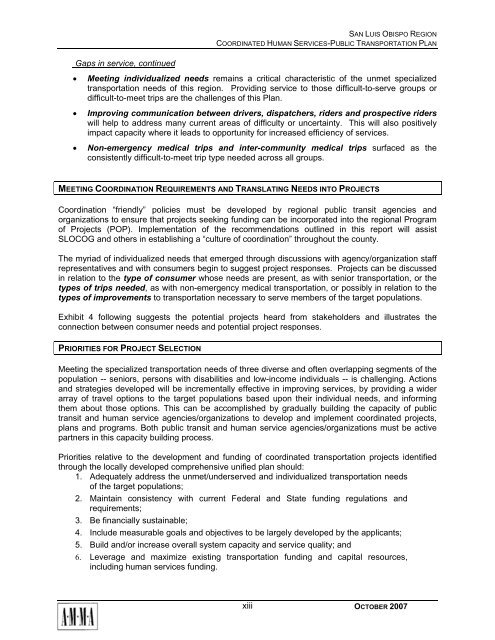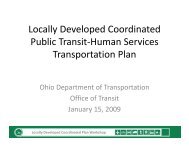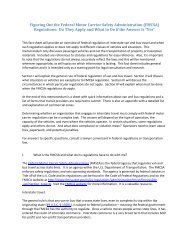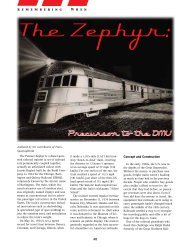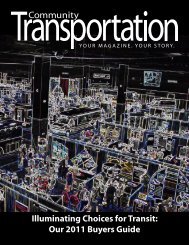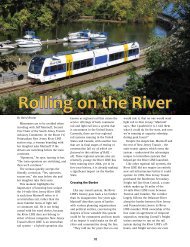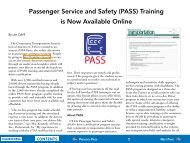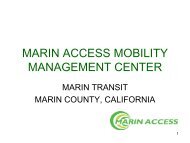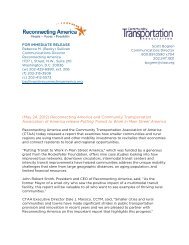San Luis Obispo - Caltrans - State of California
San Luis Obispo - Caltrans - State of California
San Luis Obispo - Caltrans - State of California
You also want an ePaper? Increase the reach of your titles
YUMPU automatically turns print PDFs into web optimized ePapers that Google loves.
Gaps in service, continued<br />
SAN LUIS OBISPO REGION<br />
COORDINATED HUMAN SERVICES-PUBLIC TRANSPORTATION PLAN<br />
• Meeting individualized needs remains a critical characteristic <strong>of</strong> the unmet specialized<br />
transportation needs <strong>of</strong> this region. Providing service to those difficult-to-serve groups or<br />
difficult-to-meet trips are the challenges <strong>of</strong> this Plan.<br />
• Improving communication between drivers, dispatchers, riders and prospective riders<br />
will help to address many current areas <strong>of</strong> difficulty or uncertainty. This will also positively<br />
impact capacity where it leads to opportunity for increased efficiency <strong>of</strong> services.<br />
• Non-emergency medical trips and inter-community medical trips surfaced as the<br />
consistently difficult-to-meet trip type needed across all groups.<br />
MEETING COORDINATION REQUIREMENTS AND TRANSLATING NEEDS INTO PROJECTS<br />
Coordination “friendly” policies must be developed by regional public transit agencies and<br />
organizations to ensure that projects seeking funding can be incorporated into the regional Program<br />
<strong>of</strong> Projects (POP). Implementation <strong>of</strong> the recommendations outlined in this report will assist<br />
SLOCOG and others in establishing a “culture <strong>of</strong> coordination” throughout the county.<br />
The myriad <strong>of</strong> individualized needs that emerged through discussions with agency/organization staff<br />
representatives and with consumers begin to suggest project responses. Projects can be discussed<br />
in relation to the type <strong>of</strong> consumer whose needs are present, as with senior transportation, or the<br />
types <strong>of</strong> trips needed, as with non-emergency medical transportation, or possibly in relation to the<br />
types <strong>of</strong> improvements to transportation necessary to serve members <strong>of</strong> the target populations.<br />
Exhibit 4 following suggests the potential projects heard from stakeholders and illustrates the<br />
connection between consumer needs and potential project responses.<br />
PRIORITIES FOR PROJECT SELECTION<br />
Meeting the specialized transportation needs <strong>of</strong> three diverse and <strong>of</strong>ten overlapping segments <strong>of</strong> the<br />
population -- seniors, persons with disabilities and low-income individuals -- is challenging. Actions<br />
and strategies developed will be incrementally effective in improving services, by providing a wider<br />
array <strong>of</strong> travel options to the target populations based upon their individual needs, and informing<br />
them about those options. This can be accomplished by gradually building the capacity <strong>of</strong> public<br />
transit and human service agencies/organizations to develop and implement coordinated projects,<br />
plans and programs. Both public transit and human service agencies/organizations must be active<br />
partners in this capacity building process.<br />
Priorities relative to the development and funding <strong>of</strong> coordinated transportation projects identified<br />
through the locally developed comprehensive unified plan should:<br />
1. Adequately address the unmet/underserved and individualized transportation needs<br />
<strong>of</strong> the target populations;<br />
2. Maintain consistency with current Federal and <strong>State</strong> funding regulations and<br />
requirements;<br />
3. Be financially sustainable;<br />
4. Include measurable goals and objectives to be largely developed by the applicants;<br />
5. Build and/or increase overall system capacity and service quality; and<br />
6. Leverage and maximize existing transportation funding and capital resources,<br />
including human services funding.<br />
xiii<br />
OCTOBER 2007


